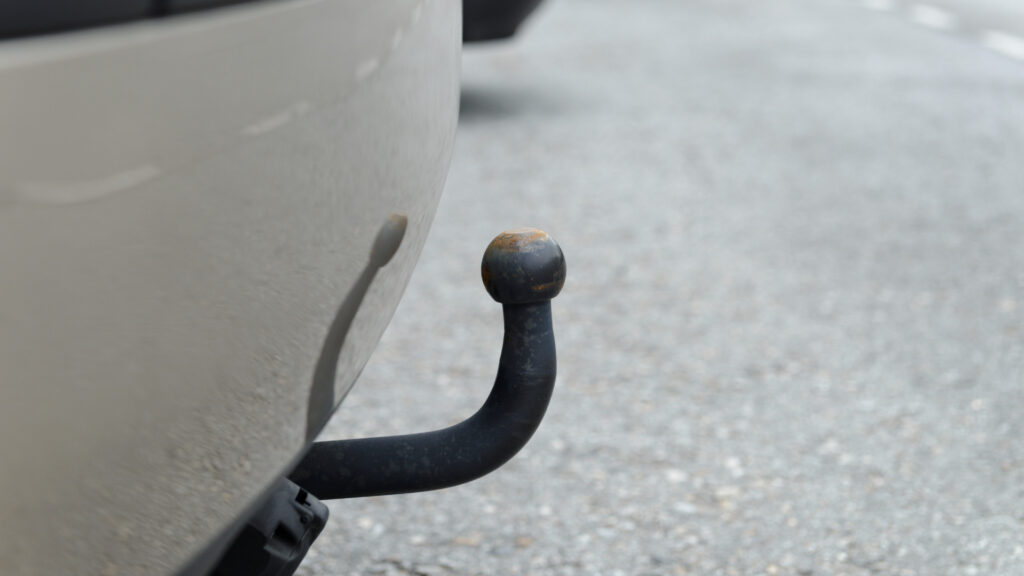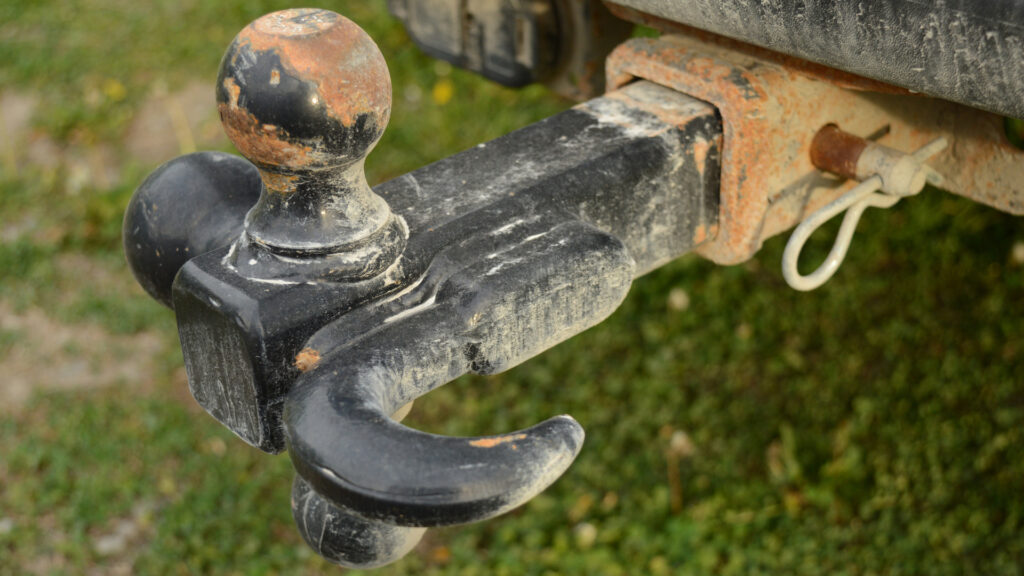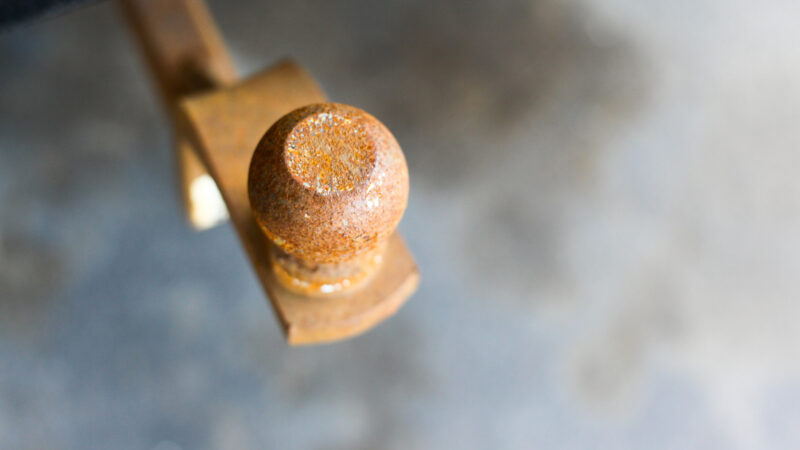Table of Contents Show
Are you having trouble with your trailer hitch getting stuck on the ball? Few things are worse than getting your RV or trailer positioned perfectly and then struggling to unhitch.
While this causes frustration, it doesn’t have to ruin your day. We’ve found a handful of things you can try the next time you end up in this situation.
Today, we’ll learn how you can fix a stuck trailer hitch stuck on the ball. Let’s get started!
What Are Trailer Hitches?
Trailer hitches attach to a vehicle and connect to a trailer. They consist of a ball and socket joint, which allows the trailer to attach to the vehicle and be pulled behind it.
Trailer hitches provide a secure connection between the vehicle and the trailer, ensuring the safe transport of goods and materials.
They come in various sizes and weight capacities to accommodate different vehicles and trailers, and you have several different types of hitches, including a receiver, fifth-wheel, and gooseneck hitches.
Before connecting a trailer to your vehicle, you must confirm your vehicle’s towing capabilities. Overloading your tow vehicle or trailer hitch can cause dangerous and costly accidents.
What Are Hitch Balls?
Hitch balls are parts of a trailer hitch that connect the hitch to the trailer coupler. The ball inserts into the coupler and locks the ball in place. This helps ensure the trailer stays attached to the tow vehicle while traveling.
Steel is typically the metal of choice for these balls, which comes in various sizes and weight capacities. You must ensure you match the hitch ball with the trailer specifications you plan to tow.
The size and type of the one you use depend on the specific trailer and hitch in each situation.

Why Do Trailer Hitches Get Stuck on the Hitch Ball?
There are several reasons why a hitch could get stuck on a ball. Normal wear and tear and exposure to the elements are some of the primary causes of stuck hitches.
You must regularly maintain your equipment and keep it free of rust and corrosion. Keeping the moving parts lubricated and in good condition ensures they last for years.
Additionally, you have the possibility that the hitch was installed incorrectly. Getting the proper alignment for unhitching could be difficult if this is the case. Whether you installed your hitch or paid a professional, ensure everything aligns properly.
The trailer’s and tow vehicle’s position can make it challenging to unhitch a trailer. You could end up with too much or too little weight on the ball. Depending on the situation, the trailer’s position could put pressure on the hitch ball and cause friction when you try to remove it.
Ways to Try to Loosen a Stuck Trailer Hitch From the Ball
If your trailer hitch gets stuck on the ball, you can do a handful of things to loosen it. Let’s look at some things you can try to free your hitch ball from your hitch.
Add Lubrication
A lack of lubrication is one of the most common causes of hitch stuck on a ball. If you don’t already, have a can of spray lube readily available when towing a trailer.
As you can see, you never know when it will come in handy. WD-40 is one of the most popular brands and is readily available online and at many retailers.
Spray the lubricant into the coupler as best as you can. This can help moving parts move and release the hitch ball. Once free, you’ll want to generously spray the moving parts and move them several times to work the lubricant into the parts.
- Extend Hitch Ball And Coupler Life -- Protect hitch-balls and receivers from corrosion with this high-film strength and...
Slightly Move Your Vehicle Forward and Back
Sometimes a trailer may get stuck on the hitch ball because of the ball’s placement on the coupler. Moving your vehicle forward and back can adjust the ball’s position in the coupler.
Just know where everyone is and that there’s nothing in your way. Some people can get easily distracted with the hitching process and forget to look out for objects or people who might get in their way.
Some drivers make it a habit always to make their last move backward to reduce the pressure placed on the coupler from the hitch ball. If you’re parking your RV or trailer in a pull-through spot, just make sure you back up a few inches before putting your vehicle in park.
Bounce on the Vehicle
If you struggle and get frustrated, you may have to go the extra mile and get a little more physical with your stubborn hitch. Sometimes bouncing up and down on the back of your truck can adjust the positioning of the hitch and ball. This simple act may be enough to separate the two.
When doing this, ensure you have adjusted the height of the jack to distribute weight onto it. This will help avoid damage to the hitch or coupler when it releases.
When using this method, ensure everyone keeps their fingers and other body parts free of the area.
Lightly Hit the Coupler with a Hammer
When all else fails and you get desperate, break out a hammer. We suggest carrying a rubber mallet for these situations as it will have the same impact but avoid causing damage.
Pounding the coupler with the hammer can help encourage it to release the ball. You can increase your odds by bouncing on your vehicle and hitting the coupler with a hammer.
Again, keep your fingers and other body parts away from the area during this process.
The Fundamentals of Unhitching Your Trailer
Whether you’re new to unhitching or have been doing it for years, there are some things you need to do every single time.
If not, you could make it harder on yourself than it needs to be. Let’s look at some of the basics for unhitching a trailer.
Make Reverse Your Final Move
As we said earlier, always make reverse your final move before putting your vehicle in park. Going in reverse last releases any pressure placed on the coupler from the hitch ball. Pressure on the coupler can make it extremely difficult to get it to release.
Many RVers face this issue when using pull-through campsites instead of back-in sites. Pull-through sites typically don’t require you to go in reverse unless you overshoot your landing spot or need to make another adjustment.
Luckily, it only takes a second or two, and taking the time can make it easy to disconnect your trailer.
Pro Tip: If you’re new to towing RVs, then check out our RV towing guide for newbies!
Confirm the Release of the Coupler
Once you chock your wheels and lower your tongue jack, you’ll want to release the coupler. Releasing the coupler typically involves lifting and pulling back on a latch on the tongue of the trailer. If all goes as planned, it should move freely and rather easily.
However, the coupler occasionally gets stuck or doesn’t want to let go of the ball. This is when you start using some of the methods we’ve shared with you.
Use Tongue Jack to Adjust Weight
It can take some time to learn, but you want to find the sweet spot to make releasing the coupler as easy as possible. The sweet spot is where you have the right weight on the tow vehicle so the coupler can easily release.
You may need to adjust the height and position of the trailer with the tongue jack to find the sweet spot. Depending on the level of where you park, this spot can constantly change.
Once free, you only need to raise the trailer an inch or two to pull your vehicle forward and out of the way. With your tow vehicle out of the way, you can use the tongue jack to adjust the height of your trailer so it sits level.
- EASY INSTALLATION — Complete with all necessary hardware and pins, installation for the Power Tongue Jack is fast and...
- TIME-SAVING — Say goodbye to cranking your manual jack. With the push of a button, you can raise or lower your a-frame...
Keep Coupler and Ball Clean
If it is difficult to disconnect your trailer, it’s a good idea to take the time to figure out why. If you can keep your coupler and hitch ball clean, you can help avoid some of the most frustrating situations.
When not using it, many drivers will remove their hitch ball to avoid dirt and grim from getting on it. These items can find their way into the coupler the next time you connect your trailer, making it harder to unhitch.
Keep in Mind: Should you DIY or Bring in a Professional for a 5th wheel hitch installation? Let’s dive in!

Use Dry Lube Regularly
Keeping your gear and equipment lubricated can help you avoid problems down the road. How frequently you apply dry lube will depend on how often you’re towing.
However, we recommend adding a can of spray lubricant to the tool bag that you carry in your vehicle. You may not need to use it often, but you’ll be glad you have it when you do.
- Dry Lube PTFE Spray reduces friction and wear on blades and bits, door and window tracks, slides, conveyor belts,...
- Ideal for reducing friction and wear on multiple surfaces. It won t attract dirt or dust, and is safe for temperatures...
A Hitch Stuck on the Ball Can Leave You in a Bind
Having a hitch stuck on the ball can make you frustrated, especially after a long day. However, if you know how to handle yourself and the trailer, you can quickly get out of the bind.
The next time you find yourself stuck or battling a stubborn hitch ball, try the tips and tricks we’ve shared with you. Let us know which one works best for you and any other tips you might have when battling a stuck hitch ball.
Last update on 2025-01-19 / Affiliate links / Images from Amazon Product Advertising API





![[1 Pack] 4oz Trailer Hitch Ball Lubricant - Grease to Reduce Friction and Wear on Tow Hitch Mount Balls, King Pins, etc. - Waterproof Lube Made in The USA](https://m.media-amazon.com/images/I/41Qz6hcAqLL.jpg)



